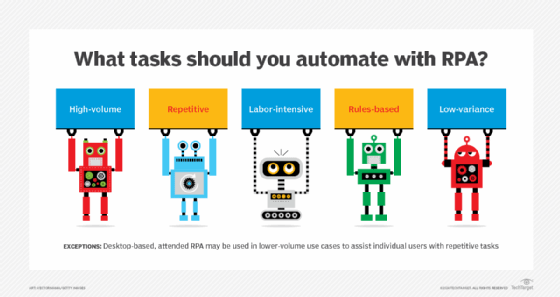What is digital labor?
Digital labor is work that's performed by robotic process automation (RPA) systems and interactive applications, including chatbots and digital assistants. The digitalization of labor is being facilitated by technologies such as cloud computing, social media, big data, mobility, data analytics and machine learning.
These technologies have greatly expanded the volume and variety of data available for RPA systems, which in turn bolster the quality and range of artificial intelligence's (AI's) impact and the utility of RPA systems that are interactive.
RPA software can be trained or configured without the need to manipulate code, so business users can access and control the automation technology without the need for IT specialists. What distinguishes RPA from traditional automation is its ability to integrate multiple systems and enable them to adapt to changing circumstances. In addition, advances in AI have improved the decision-making capacity of many RPA systems, increasing their functional potential and enhancing the quality of human interaction with chatbots and digital assistants.
That decision-making support has made AI increasingly powerful as a digital labor application component, enabling more sophisticated response ranges not only in individual RPA systems, but also between interfaced RPA systems. AI's enhancement of chatbot and digital assistant functionality has widened the range of response and overall utility of those applications.
What are the types of digital labor?
A primary driver in the shift to digital labor is RPA, which includes different technologies, such as the following:
- Basic process automation. These include macros, scripts, screen scraping and business workflow technologies that sit at the Open Systems Interconnection presentation layer.
- Enhanced process automation. These technologies, which use AI and natural language processing, include chatbots and digital assistants.
- Cognitive platforms. These include application software that can parse context and understand meaning.

What is a digital worker?
As mentioned above, digital labor is a broad category that includes RPA, chatbots, digital assistants, and other applications and systems that perform digital work. The purest form of digital labor is the former -- systems that perform work automatically and don't require human interaction to get the job done.
One of a digital worker's defining characteristics is that it's process-oriented, not just task-oriented. A digital worker is an application that can execute a complex workflow -- a process including many tasks, not just one. Digital workers can take over entire processes that might normally involve several human workers.
One example might be a digital worker that handles invoice processing from beginning to end. Typically, the lifecycle of an invoice takes it through several departments, from sales to finance to procurement, where it would be touched along the way by several people in a traditional process.
Such processes often involve decision-making when the path of the process isn't straightforward, but includes options based on changing conditions, or when something goes awry, and some adaptation must be made. This is where AI comes in, providing that decision-making capability so that a digital worker process doesn't stall.
What are the benefits of a digital worker?
Digital workers offer the following benefits:
- Free human beings from tedious, time-consuming chores so that they can tackle more challenging tasks.
- Make processes more reliable by reducing human error.
- Work 24/7 and don't need to take breaks.
- Increase the overall adaptability of the enterprise.
- Learn from their own experience -- provided that they have AI or machine learning components.
How do digital workers differ from RPA bots?
While digital workers and RPA bots have many of the same components and capabilities, the primary difference between the two is that RPA bots are generally restricted to single tasks, or at most, simple processes. Digital workers, meanwhile, are autonomous agents that can execute many tasks and interact intelligently with other systems.
It's also useful to understand that RPA bots and chatbots have a key difference. Like an RPA bot, a chatbot is generally restricted to a single function or a small, narrowly defined set of functions, intended for communication with a human. The chatbot acquires information from a person, provides information to a person or both.
An RPA bot, on the other hand, is usually isolated from any communication with people altogether. Like a digital worker, it can get along with no help from a human.
Where is digital labor being used?
There are few industries where digital labor isn't being used, at least somewhat, as the digital economy continues to expand and digital technologies rapidly grow in sophistication and drop in price. Chatbots can be found everywhere, of course, primarily for customer service, but also for a growing range of other customer-interactive purposes. Chatbots, for instance, are increasingly found in employee onboarding processes.
The proliferation of digital media is just one driver of RPA bot deployment, as single-task bots have taken up service doing data collection and scraping to feed other systems. Bots of this type are also frequently found on the IT side of things, cleaning up data stores and managing subnetworks used by the internet of things and other technologies.
The more powerful digital workers are found in large-scale, high-volume systems where processes can number in the dozens or even hundreds. Examples of industries deploying such workers include banking and finance, insurance, and healthcare.
The broader implications of digital labor
Discussions around digital labor often include the impact its globalization will have on mature economies. Employing software robots can cost as little as one-third that of employing an offshore worker, and robots are expected to disrupt current outsourcing practices. The increasing digitalization of labor is expected to drastically reduce the amount of effort required to produce services and products and will generate new jobs to support RPA.
The digital age has brought about rapid and persistent change in industries of all kinds, and some of that change has been difficult. Many human workers feel threatened by the advent of digital workers, whom they might view as job-stealing replacements. The future of work is uncertain to some degree, as digital workers are comparatively less expensive than their human counterparts. Labor markets are already being heavily affected, and that will continue to increase in the coming years.
On the other hand, the positive aspect of the freedom created by the inclusion of digital labor -- giving humans more time in their workday to perform more meaningful, challenging tasks -- serves as a balance here. A lot of adaptation will take place in the next few years, and it will certainly not be painless. A necessary first step is to fully understand digital labor, its benefits and its drawbacks as these adaptations proceed.
Learn how humanoid robots, which are a combination of AI and robotics, work and what types of services they provide.







